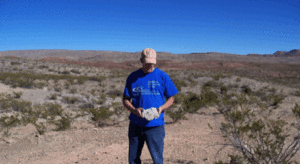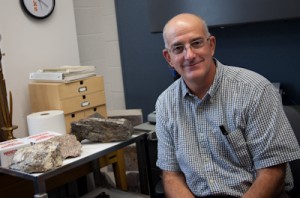Dr. Mark D. Busa
Professor, Physics and Physical Sciences
Department: School of Allied Health, Business, and STEM
Phone: 860-343-5779
Email: mbusa@mxcc.edu
Location: Wheaton 217
See office hours here
Read Biography
Courses:
- PHY*110 Introductory Physics
- PHY*121-122 General Physics I and II
- PHY*221-222 Calculus Based Physics I and II
- EAS*107 Earth Resources
As a geology and physics professor, Mark D. Busa shares his passion and curiosity about nature while presenting exciting demonstrations, lectures and experiential learning activities. From a scientific perspective, he provides current and relevant information that is not just knowledge but leads to solving problems. “As a role model, students should see joy in their instructor, and how this joy promotes fun and creative thinking,” he says.
After years of working in industry and pursuing degrees in geology, Mark came to Middlesex Community College in the fall of 2000.
Following his graduation from New Mexico Tech with a bachelor’s degree in geology, Mark went to work for Western Geophysical Company conducting exploration seismology in the Williston Basin area of western North Dakota. After that, he worked for a small oil company in Carlsbad, N.M., logging oil wells in southwest Texas. Mark returned to Connecticut and worked in the civil engineering and environmental engineering business. For 16 years, he was a project geologist working on dams, roadways, bridges and hydrogeological investigations. During that time, he began teaching as an adjunct instructor for Quinebaug Valley Community College and the University of New Haven while completing his master’s and doctoral degrees at the University of Connecticut. His research at UConn consisted of field studies and detailed sectioning of large staurolite porphyroblasts, to understand the growth and deformation history of the rocks in the Bolton syncline of eastern Connecticut.
 Mark has been collecting rocks from local areas in the Hartford Basin and in eastern Connecticut, and from two locations in central New Mexico: the Tertiary volcanics in the Socorro caldera, from Nogal Canyon; and the upper Pennsylvanian/lower Permian sedimentary rocks in the Quebradas, east of the Rio Grande. These rocks are part of MxCC’s collection available for undergraduate study. He and his students have collected a wide variety of rocks from the local and regional area. From his work experience in hydrogeology, Mark is still interested in new techniques to investigate the subsurface, especially geophysical tools.
Mark has been collecting rocks from local areas in the Hartford Basin and in eastern Connecticut, and from two locations in central New Mexico: the Tertiary volcanics in the Socorro caldera, from Nogal Canyon; and the upper Pennsylvanian/lower Permian sedimentary rocks in the Quebradas, east of the Rio Grande. These rocks are part of MxCC’s collection available for undergraduate study. He and his students have collected a wide variety of rocks from the local and regional area. From his work experience in hydrogeology, Mark is still interested in new techniques to investigate the subsurface, especially geophysical tools.
Mark teaches a wide variety of classes at MxCC, including General and Calculus Based Physics I and II, Introductory Physics, Earth Science, Natural Disasters, Earth Resources, and, when needed, Principles of Astronomy and Introduction to Engineering. He works closely with Professors Lin Lin and Hubert Godin in Manufacturing Machine Technology and Engineering Science programs.
Mark is affiliated with the American Institute of Professional Geologists, the Connecticut Geological Society and is an honorary member of Epsilon Pi Tau (international society for technology). His interests include music, trees and turf.
Selected publications/presentations:
Busa, M. D., 1987. Mechanism of fluid flow in the Mesozoic Higganum dike, Connecticut. Geological Society of America Abstract 118391, Pittsburgh, Pennsylvania.
Busa, M. D., 1990. Rolled staurolite porphyroblasts in the Littleton schist, eastern Connecticut. Master of Science thesis, University of Connecticut, 33 p.
Busa M. D. and N. H. Gray, 1992a. Rotated staurolite porphyroblasts in the Littleton schist at Bolton, Connecticut, U.S.A. Journal of Metamorphic Geology, 10, 627-636.
Busa, M. D. and N. H. Gray, 1992b. Staurolite porphyroblasts and deformation in the Great Hill syncline, Bolton, Connecticut, in Guidebook for fieldtrips in the Connecticut Valley region of Massachusetts and adjacent states. New England Intercollegiate Geological Conference 84th Meeting, Amherst, Massachusetts, 216-228.
Gray, N. H., and M. D. Busa, 1994. The three-dimensional geometry of simulated porphyroblast inclusion trails: inert-marker, viscous-flow models. Journal of Metamorphic Geology, 12, 575-587.
Kraemer, C. A., W. E. Penn, and M. D. Busa, 1995. The use of the Hydropunch for contaminant plume delineation. Proceedings American Standards for Testing of Materials, Philadelphia, Pennsylvania.
Busa, M. D., and W. E. Penn, 1995. Integration of site stratigraphy and borehole geophysics in the design and installation of a monitoring well network. Geological Society of America Abstract 19016, Cromwell, Connecticut.
Busa, M. D. and N. H. Gray, 1998. The internal structure and rotation of syndeformational fan-shaped staurolite porphyroblasts in the Littleton schist, Connecticut. American Geophysical Union Abstract V32B-3, Boston
Busa, M. D. and N. H. Gray, 2002. Orientation and three-dimensional geometry of inclusion trails in staurolite porphyroblasts from the east limb of the Great Hill syncline, eastern Connecticut. Geological Society of America Abstract 31594, Springfield, Massachusetts.
Busa, M. D. and N. H. Gray, 2005. Fan-shaped staurolite in the Bolton syncline, eastern Connecticut: evidence for porphyroblast rotation during growth. Journal of Metamorphic Geology. 23, 881-895.
Busa, M. D., 2006. The external morphology and internal fabric of staurolite from the Bolton syncline, eastern Connecticut: implications for the interpretation of inclusion trails in porphyroblasts, Ph.D. dissertation, University of Connecticut, 188 p.
Busa, M. D., 2007. Lithologies and structures in the Bolton syncline, Bolton Notch area, Connecticut, field trip F4, National Association of Geoscience Teachers New England Section, Manchester Community College, Manchester, Connecticut and Dinosaur State Park, Rocky Hill, Connecticut, October 13, 2007.


